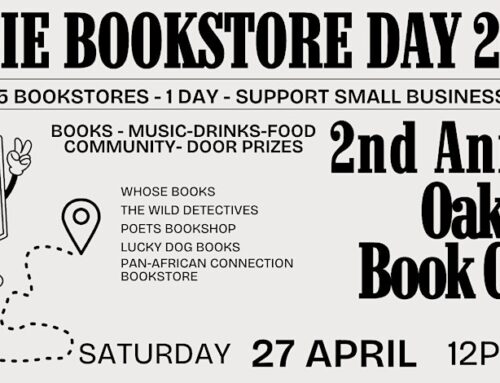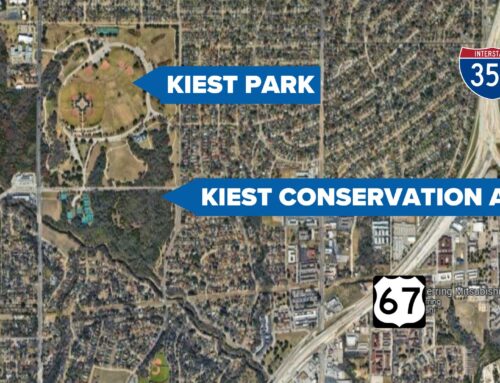In this episode of the Uninformed Parent, I visited Reagan Elementary to check out the school’s project-based learning initiative. The Reagan students pinpointed problems that hit home for them — such as Oak Cliff’s water supply, and why they were losing classmates to new developments in the uber popular Bishop Arts District, where their school is located. The fourth- and fifth-graders pursuing these questions applied their classroom learning to real-world problems — and schooled the rest of us in the process.
Ms.Stone: Good morning, are you Ms. Mitchell?
Keri Mitchell: I am. And you are?
Ms.Stone: Ms. Stone.
Keri Mitchell: Ms. Stone, so nice to meet you. Thank you for having me.
Ms.Stone: Certainly! We’ll find a little spot and put her things down. Make yourself at home.
Keri Mitchell: Thanks.
Ms.Stone: We just have some fourth and fifth graders in here, it looks like. What this project-based learning thing is — then I’m going to do the talking — is it’s just kind of an overview. We pick a question that is somewhat interesting to the students, and then they explore it over a long period of time and make questions about it. Anyway, then on the 26th we’re going to present where family, community people can come and, for example, fourth grade, went to Trinity Audubon Center, and the representatives from that center will come back and kind of see what we’ve done with what they’ve taught them. So it’s a full circle, kind of.
Keri Mitchell: That’s great.
Ms.Stone: Yeah, so fourth grade, come on, show your thing and enjoy
[presentation in both English and Spanish]
Student: Hello, good morning to everyone. Today we are going to be presenting our presentation of Pure H2O: Why is it important to keep water clean in our community?
Where does our water come from? Dallas’ water supply comes from six reservoirs in the Elm Fork of the Trinity River: Grapevine, Lewisville, Ray Roberts, Ray Hubbard, Fork and Tawakoni. Ray Hubbard is the only reserve completely owned and operated by the city of Dallas, although there is an aquifer below Dallas where water hasn’t been used for many years due to the aquifer water quality.
How does Dallas Water utilities treat our water? DWU uses settling, filtering, chemicals and ozone disinfection to purify its drinking water. Chloramine, a combination of chlorine and ammonia, which is less hazardous than chlorine alone, and ozone are used for disinfection. Lime and iron sulfate are used to remove suspended solids and for corrosion control, and activated carbon is used to control taste and odor. Fluoride is also added to the water to prevent tooth decay.
Let’s talk about poop. No really, let’s talk about poop. Does your family own a dog? Do you know other people with a dog? What do you think happens to all of the dog waste our pets leave behind? Right, down the storm drain and into the water. When you think about how many people own dogs, this can really build up.
Did you know dog waste contains bacteria that can harm people? When people don’t pick up after dogs, this bacteria ends up in the water that we drink. Don’t worry, nobody has to give up their pooch. Pet owners can improve water quality by picking up after their pets and throwing their pets’ waste into a trash can so the bacteria can’t go into the water that we drink.
All of these facts are to inform you that is important to keep water clean in our community, because it is important for us and the animals. We need to do the most possible to save our water because, like we said, it is important for us and our community.
Thank you for coming this morning. We thank you for coming and seeing our presentation of Pure H2O. Do you have any questions?
Keri Mitchell: Oh I have so many, but that was so good. I love that you ad-libbed night to morning. I noticed.
Ms. Stone: What they did was they went on a field trip to the Trinity Audubon park, and they involved themselves in a poster contest for the City of Dallas about that. Then the final product was when they got together and had all their information. They did the translation themselves, put the PowerPoint together, did all of that.
Keri Mitchell: Very impressive guys.
Ms.Stone: It really is. So the connection is our third grade is doing animal habitat. You won’t see all those until that night. Parents will get to go from place to place and see all the connection between all the activity.
Keri Mitchell: Do you care if I ask them a couple questions? I’m just curious. So you’ve done all this work? What has been the thing that’s maybe changed the way you live? Has it changed your water habits? How much you use or, you mentioned dog poop, are you picking it up? You know, how’s that working for you?
Well, it can work like — about up dog poop. You can pick up the dog poop. It can work, so we don’t get sick.
Keri Mitchell: Do any of you have dogs?
Student: Yes. I have three.
Keri Mitchell: You have three.
Student: I pick it up every morning, and every time I get back from school. I keep rotating. I pick it up, because I know I don’t want to get sick.
Keri Mitchell: Wow, did that change because you did this work?
Student: Yep.
Keri Mitchell: That’s really cool. That’s the kind of thing — if I understand with project-based learning, one of the points of it is to help us take some knowledge from the classroom and apply it to the real world so that it actually changes the way we’re thinking about it and living, too, which is very cool.
Ms.Stone: So let’s go ahead. I know you have other things on the day, but let’s go ahead and, fifth grade, y’all kind of do your deal.
Student: Our driving question was, “How can we impact positive change?” We went on the neighborhood walk. Ms.Stone took some pictures. They’re all here.
Student: Good morning, we took a student survey to see how many students have moved. From second- to third-grade, nineteen students said they had moved and seventy-four said that they did not move. We also asked them, “Do you live in the same house or apartment as when school started?” And most of them said, “Yes.”
Ms.Stone: 149 did not move but 44 moved, but they’re still attending school here, which is significant.
Keri Mitchell: Yeah, it is.
Ms.Stone: So even with changes, Joseph, tell us about your experience with that.
Joseph: I actually moved this year, but I wasn’t forced to move. They gave me the house. They offered it to us, so we moved in. I actually live right here. I live closer, which is actually something better than when I lived over there.
Ms.Stone: What’s the next slide about?
Student: After we did the student survey, we did a community survey. We asked neighbors to tell us the name of their street and the best thing about living in their neighborhood
Student: They said that the best thing about living in the neighborhood was that stores were close by and it was peaceful and quiet. We also asked them what they’d like to see more. And they answered grocery stores and more people walking. But overall people are glad to live in the Reagan neighborhood.
Ms.Stone: And that’s just not something you assume; they have the data that proves it. I think that’s important for fifth-graders is that people didn’t run away. You know, even though change was happening
Student: After we did the student survey and the community survey, we went on the walk and we asked the developers some questions. We asked them, “How do you do think this project will help the neighborhood?” And they said that they will provide new housing. We asked them, “How do you know that the houses will be rented or owned?”
Ms.Stone: Mariana, what was that? What did they tell us that they did?
Mariana: The new projects will be able to blend in all their houses providing a good mix of styles.
Ms.Stone: Right? And they did a survey too. They went out and they did what we adults would call the “feasibility study” to predict the number of people right that would live in that house. Did we catch him on something though?
Student: Yes.
Ms.Stone: Yeah. Yeah. Remember that time we asked about, “Will it bring new population?” and what did he say?
Student: He said, “They will bring news children for us to play with.”
Ms.Stone: But then what happened, Daisy? He said that it was gonna be what?
Daisy: Only one room.
Ms.Stone: It was only one bedroom.
Daisy: So we didn’t understand that.
Ms. Stone: It was kind of a disconnect with what they were … yeah. We stayed positive with him, but we weren’t sure that they got the idea that we wanted more children in the neighborhood. We’ll see. They know we’re on it, that we’re going to check back in with him and see if that’s going to hold true or not.
Keri Mitchell: How did you come up with this idea in the first place? What kind of drove this particular question?
Student: We were just doing our work one day, and Joseph told us that story. And we’re like, “I wonder how many people have moved and if they were forced to move, or they just chose to move by themselves.” And we started to work on the poster, and that’s when we got the idea to go on a nature walk.
Keri Mitchell: What’s great about this, in terms of what I do, is that’s how stories start. We have a question that comes up and we go, “Well, how do we figure out the answer?” And I love that you guys didn’t just make an assumption. You asked people the questions, and then you gathered the data so that you had the answer. Did you feel better about the situation after you asked all the questions or about the same or worse or what do you think?
Student: Well, when we noticed that more people stayed at their houses, we felt more comfortable with our neighborhood that no one in our neighborhood is forcing others to leave.
Ms.Stone: We want to get the word out to other people that there are good things going on. It’s not just about, you know, fancy coffee shops and $5 slices of pie.
Keri Mitchell: No people live here. You live here. You guys all, can you walk to school?
Students: Yeah.
Keri Mitchell: Well, how did you find the neighbors? When you asked the neighborhood surveys? How did you find those people to ask the questions to?
Ms.Stone: At home. Didn’t we guys?
Student: Yes.
Keri Mitchell: Was that maybe your parents? Is that the neighborhood survey?
Ms.Stone: Yeah. Yes, their grandparents and — where is that survey?
Keri Mitchell: So, people who live here in the neighborhood.
Student: Yes.
Keri Mitchell: Many of you have been school here since you were younger. Have you noticed people leaving because of all the … you have. That probably prompted this, too.
Keri Mitchell: Hi there. Good morning.
Ms. Meza: Welcome, welcome. We’re glad you were able to come.
Ms. Stone: This is our principal, Ms. Meza. She’s just been very instrumental and supportive of the learning that’s going on.
Ms. Meza: What a great joy to be able to support the school with this personalized learning.
Thanks for listening to the Uninformed Parent. In the next episode, we’ll talk to Oak Cliff parent Lauren Corkery about her detailed, data-infused search for a school for her children.
This podcast is a production of Advocate Media with music by HookSounds.





